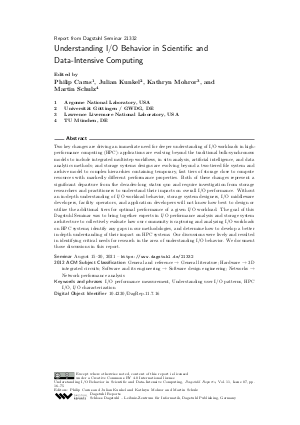Understanding I/O Behavior in Scientific and Data-Intensive Computing (Dagstuhl Seminar 21332)
Authors Philip Carns, Julian Kunkel, Kathryn Mohror, Martin Schulz and all authors of the abstracts in this report
-
Part of:
Issue:
Dagstuhl Reports, Volume 11, Issue 7
Part of: Volume: Dagstuhl Reports, Volume 11
Part of: Journal: Dagstuhl Reports (DagRep) - License:
 Creative Commons Attribution 4.0 International license
Creative Commons Attribution 4.0 International license
- Publication Date: 2021-12-22
File

PDF
DagRep.11.7.16.pdf
- Filesize: 3.91 MB
- 60 pages
Document Identifiers
Subject Classification
ACM Subject Classification
- Software and its engineering → Software design engineering
- Networks → Network performance analysis
Keywords
- I/O performance measurement
- Understanding user I/O patterns
- HPC I/O
- I/O characterization
Metrics
- Access Statistics
-
Total Accesses (updated on a weekly basis)
0PDF Downloads0Metadata Views
Abstract
Two key changes are driving an immediate need for deeper understanding of I/O workloads in high-performance computing (HPC): applications are evolving beyond the traditional bulk-synchronous models to include integrated multistep workflows, in situ analysis, artificial intelligence, and data analytics methods; and storage systems designs are evolving beyond a two-tiered file system and archive model to complex hierarchies containing temporary, fast tiers of storage close to compute resources with markedly different performance properties. Both of these changes represent a significant departure from the decades-long status quo and require investigation from storage researchers and practitioners to understand their impacts on overall I/O performance. Without an in-depth understanding of I/O workload behavior, storage system designers, I/O middleware developers, facility operators, and application developers will not know how best to design or utilize the additional tiers for optimal performance of a given I/O workload. The goal of this Dagstuhl Seminar was to bring together experts in I/O performance analysis and storage system architecture to collectively evaluate how our community is capturing and analyzing I/O workloads on HPC systems, identify any gaps in our methodologies, and determine how to develop a better in-depth understanding of their impact on HPC systems. Our discussions were lively and resulted in identifying critical needs for research in the area of understanding I/O behavior. We document those discussions in this report.
Cite As Get BibTex
Philip Carns, Julian Kunkel, Kathryn Mohror, and Martin Schulz. Understanding I/O Behavior in Scientific and Data-Intensive Computing (Dagstuhl Seminar 21332). In Dagstuhl Reports, Volume 11, Issue 7, pp. 16-75, Schloss Dagstuhl – Leibniz-Zentrum für Informatik (2021)
https://doi.org/10.4230/DagRep.11.7.16
BibTex
@Article{carns_et_al:DagRep.11.7.16,
author = {Carns, Philip and Kunkel, Julian and Mohror, Kathryn and Schulz, Martin},
title = {{Understanding I/O Behavior in Scientific and Data-Intensive Computing (Dagstuhl Seminar 21332)}},
pages = {16--75},
journal = {Dagstuhl Reports},
ISSN = {2192-5283},
year = {2021},
volume = {11},
number = {7},
editor = {Carns, Philip and Kunkel, Julian and Mohror, Kathryn and Schulz, Martin},
publisher = {Schloss Dagstuhl -- Leibniz-Zentrum f{\"u}r Informatik},
address = {Dagstuhl, Germany},
URL = {https://drops.dagstuhl.de/entities/document/10.4230/DagRep.11.7.16},
URN = {urn:nbn:de:0030-drops-155891},
doi = {10.4230/DagRep.11.7.16},
annote = {Keywords: I/O performance measurement, Understanding user I/O patterns, HPC I/O, I/O characterization}
}
